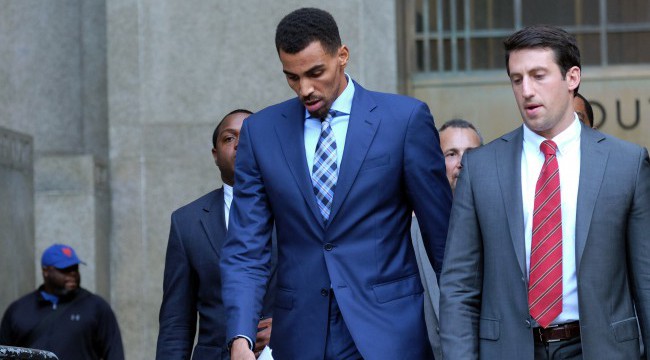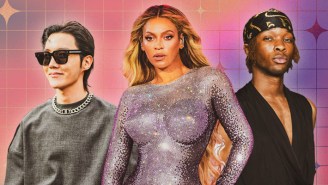
Thabo Sefolosha’s criminal trial on charges of resisting arrest and obstructing justice began earlier this week. The charges stem from an incident back in April when NYPD officers got into a physical altercation with Sefolosha after asking him to clear the area following a stabbing that had occurred close by. Sefolosha’s trial centers on the details of this altercation. The only concrete fact so far is that Sefolosha suffered a broken leg that caused him to miss the playoffs.
Normally, defendants in a criminal trial do not testify in order to avoid unintentionally incriminating themselves. However, Sefolosha chose to do so because he is hell-bent on clearing his name. He turned down a plea agreement that would require him to do only a day of community service and stay out of trouble for six months.
Both sides paint an entirely different portrait of the encounter in question. The New York Times has completely different accounts of Sefolosha’s demeanor.
“He doesn’t think the rules apply to him,” Jesse Matthews, an assistant district attorney, told the jury. “Defendant displayed a sense of entitlement and disdain.”
But Mr. Sefolosha’s lawyer, Alex Spiro, portrayed him as a “quiet, introspective” person who was wrongfully arrested and brutalized after questioning seemingly arbitrary orders from an officer who had used profanity while telling him to leave a block.
Throughout the trial, the two sides told jarringly different tales of the events that transpired on that night. The physical altercation happened down the street from the nightclub where the stabbing occurred. Sefolosha, and his teammate Pero Antic, had walked to this location as instructed by the officer. The altercation started after Sefolosha made a comment about an officer John Paul Giacona’s height. Here’s how the officer described the incident.
Mr. Sefolosha moved haltingly, Officer Giacona testified, and at one point told him: “You’re mad. You’re a midget. I’d be mad, too, if I was a midget.” Officer Giacona said he had turned away as Mr. Sefolosha had rounded a corner onto 10th Avenue but turned back when he heard a commotion. He saw Mr. Sefolosha struggling with two officers, he said.
“I came in from behind, leg-swept him and placed him in handcuffs,” he testified.
That story reflects poorly on Sefolosha and wildly differs from the retelling he provided during his own testimony.
The athlete testified that he had kept moving until he reached 10th Avenue and rounded the corner, but had strongly objected to the way the officer was speaking to him. Mr. Sefolosha, who is 6-foot-6, testified that the officer, who is short, had said that even without his badge, he could defeat Mr. Sefolosha in a fight.
“I laughed a little bit,” Mr. Sefolosha testified. “I said ‘You’re 5-foot-2.’ I said, ‘If you saw me in a different place, you wouldn’t say that. You’re a midget.’”
The officer’s version of the name-calling was short, neat and reasonably believable if written in a police report. But Sefolosha expanded on the moments before the officer took him down to the ground. He was prepared to leave in an Uber with Antic, but spotted a homeless person before he entered the vehicle.
At that moment, Mr. Sefolosha spotted a panhandler named Amos Canty who earlier had asked him for money outside the club. He said he had taken a wad of bills from his pocket, peeled off a $20 bill and started to hand it to Mr. Canty. One of the officers stopped him, he said. “I didn’t understand why I wasn’t allowed to give him the money,” he said.
Then, he said, another officer pushed him. “After they pushed me, basically it was two, three, four officers on me,” he said. He added that he had told the police, “Relax, relax,” and had tried to push the cash back into his pockets. “After about five seconds, I realized that they wanted me on the ground,” Mr. Sefolosha testified. He felt a strong kick on his lower right leg and went down.
The outcome of the trial hinges on the jury believing one side’s account. The only real evidence is grainy footage, which we’ve already published, and the only witness to the incident was Pero Antic, who corroborated Sefolosha’s version of events.
If found guilty, Sefolosha could face up to 12 months in jail. The NYPD claimed that Sefolosha broke his leg before the incident, but that is highly improbable because Sefolosha played in a game earlier that evening. He is still rehabbing his broken leg as the Hawks enter preseason play.
Sefolosha plays a pivotal role for Atlanta this season after DeMarre Carroll’s offseason departure. If Sefolosha is found not guilty, he could file a civil suit for a significant monetary compensation. The National Basketball Players Association (NBPA) has also been investigating the incident since it all went down in April. Michele Roberts has fought hard for the players in her short time as president of the NBPA, and it would not be difficult to imagine her pushing hard against the NYPD if Sefolosha is cleared of all wrongdoing.
(New York Times; H/T Sports Illustrated)






